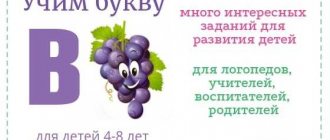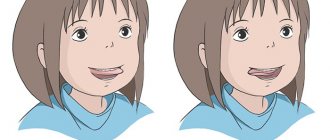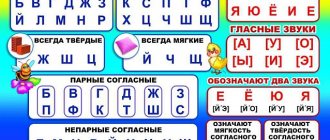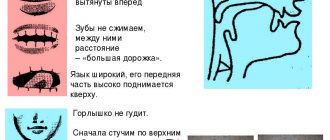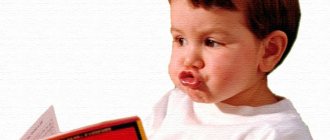Games for the sound [ы] to overcome the underdevelopment of the phonemic aspect of speech in older preschoolers
Publications on the topic:
Formation of the intonation side of speech in preschoolers with general underdevelopment of speech when reading fairy tales Intonation in words is a sea of colors It can express joy, awe, grief Without it, words are empty, even children know Without it we see everything.
Summary of a frontal speech therapy lesson on the development of the phonetic-phonemic aspect of speech in children 5–6 years old. Summary of a frontal speech therapy lesson on the development of the phonetic-phonemic aspect of speech in children 5-6 years old in a compensatory group.
Summary of a speech therapy lesson on the development of the phonetic-phonemic aspect of speech in children of the senior group “Sound [Z]. Letter Z" Correctional educational tasks: Teach children to characterize sound 3 based on acoustic and articulatory features. Introduce.
Abstract of the GCD on the development of the phonetic-phonemic aspect of speech in children of the senior group “Differentiation of sounds [U] - [A]”.
Summary of educational activities on the formation of the phonetic-phonemic aspect of speech in children with physical disabilities of the preparatory group based on speech material Cognitive and speech development. Educational areas. “Communication”: Improving the phonetic-phonemic side.
Summary of educational activities for the development of the phonemic aspect of speech in the senior speech therapy group “Consonant sounds [T]-[T']. Letter T" educational tasks: Clarification of the articulation of sounds [T] and [T']. Formation of skills to distinguish between sounds [Т] and [Т']. Learn to highlight a given one.
Consultation for teachers “Use of a developmental environment as a stimulating factor in overcoming ODD in older preschoolers.” A properly organized subject-spatial developmental environment in a speech therapy group and speech therapist’s office creates opportunities for...
GCD on the formation of the phonetic side of speech in the senior group for children with speech disorder on the Topic: “Sound and the letter Sh” Summary of the GCD in the senior compensating group for children with speech disorder on the formation of the phonetic side of speech. Topic: Sound and letter [Ш] Lesson objectives:.
"Didactic games as a means of speech development in older preschoolers." Work plan for the teacher for self-education Work plan for the self-education of the teacher of senior combined group No. 4 Ivanova A. I. Topic: “Didactic games as a means of development.
A manual for parents “Games for developing the speech of older preschoolers” The methodological manual “Games for developing the speech of older preschoolers” is aimed at helping parents in organizing work with children:
synopsis of NOD “Sound s”
Municipal budgetary preschool educational institution
"Komsomolsk kindergarten"
Summary of direct educational activities in the educational field “Speech Development” for older children
"Sound y"
Head of MBDOU
"Komsomolsk kindergarten" Teacher
A. V. Trefilova Rafikova N. Yu.
2016
Goal: to teach children to identify the vowel sound in a word that is under stress; practice forming the plural of nouns ending in –ы; teach children to find and highlight all the vowel sounds in a two-syllable word.
Equipment: individual mirrors, screen, set of pictures, set of toys.
Progress of the lesson:
The teacher invites the children to play the game: “Broken TV.” The announcer (first the teacher, then the child) imitates the pronunciation of the vowel sounds a, o, u, i, e. Children guess by the shape of their lips what sound the announcer made.
Then the announcer pronounces short words (onomatopoeia) made of two vowel sounds: ay, ua, ia.
Educator: - Who can scream like that?
Children's answers: child in the forest, baby, donkey.
Educator: What are these sounds called?
Children: vowels.
Educator: Why?
Children: because they can be sung, the air flows freely.
Educator: Guys, do you know that the sounds a, o, u, and, e have a sibling - the sound s. he is very shy. What does shy mean?
Children: modest, quiet, obedient.
Educator: sounds shy. He never comes first in a word. Hides behind other sounds in the middle or at the end of a word. Listen to the words: cheese, cats, mouse, hair, rat, hole, birds, lynx, feet, walls.
Say these words so that we clearly hear the sound y.
Now take your mirrors and look in them while saying the sound s. The teacher focuses the children’s attention so that the air coming out of the mouth passes calmly, without encountering obstacles; When pronouncing a sound, the voice is involved (hand on the throat). This means the sound y is a vowel.
Educator: now name other vowel sounds.
The teacher draws the children's attention to the pictures that he displays and asks them to name what is depicted on them.
Children's answers.
Educator: each word has two vowel sounds. Identify them and name them.
Mouse, goats, chickens, foxes.
Children's answers.
The teacher invites the children to play the game “One - Many.”
The teacher names the word in the singular, the children - the word in the plural: wasp - wasps, lip - lips, doll - dolls, ribbon - ribbons, fur coat - fur coats, hole - holes, wall - walls, bird - birds, table - tables cat - cats, tiger - tigers, whale - whales, hippopotamus - hippopotamuses, hare - hares, cucumber - cucumbers, watermelon - watermelons.
Program objectives: 1. Introduce children to the letter “Y”. 2. Continue to teach children to carry out sound-letter analysis of words and qualitatively characterize sounds. 3. Strengthen children’s ability to divide words into syllables.
4.Develop phonemic awareness. 5.Cultivate interest in learning activities. Demonstration material: subject pictures: orange, melon, apple, magnetic board, small letter “Y”, chips for sound analysis. Handout material: chips for sound analysis, letter boxes, didactic game “Hide and Seek”, pointers.
Progress of the lesson
1.Q: Children, what grows in the garden? D: Children's answers Q: What did you call now? D: Words B: Now I will pronounce pure phrases in which there is no last word. Tell me this word. Bus-bus-bus - we sowed... (watermelon). As-as-as - bought... (pineapple). In-in-in - we ate a delicious...(orange). 2.Q: Guess what grows in my garden. His brother is a tangerine, what kind of fruit is he.... D: Orange (The teacher displays a picture of an orange). Q: It's oval, like a baseball. If it's ripe, everyone is happy. D: Melon B: Round, ruddy I grow on a branch, Adults and little children love me. D: Apple 3.Q: Children, how do you find out how many syllables are in the word apple? D: The number of times you clap your hands, the number of syllables. Q: Clap the word and say how many syllables it has. D: The word apple has 3 syllables. Q: How many syllables are in the word melon? D: The word melon has 2 syllables. Q: How many syllables are in the word orange? D: The word orange has 3 syllables. Q: Name the shortest word. D: The shortest word is melon. Q: Explain why you think so? D: This word has 2 syllables, the words orange and apple have 3 syllables each. 4.Q: Name the second sound in the word melon. D: In the word melon, the second sound is “y”. Q: What do you know about him? D: This sound is sung, it is a vowel. Q: What other vowel sounds do you know? D: O, U, I, E, A Q: What other sounds are there? D: Consonants are hard and soft. Q: The one who names the hard consonant sound will sit in his place. D: call the sounds, sit down. 5.Did. game “Hide and Seek” Q: The sound “y” likes to play hide and seek. Prepare a card and a chip. I will name the words, if the sound “y” is at the beginning of the word, then put the chip in the first cell. If the sound “y” is in the middle of the word, then place the chip in the second cell. And if you hear the sound “y” at the end of a word, where do you put the chip? D: In the third box. The teacher names the words. Children place the chip in the correct cell, in accordance with the position of the sound. (smoke, soap, birch, son, lid, pine, etc.) Q: What conclusion can be drawn about the sound “s”? D: This sound can be in the middle of a word, at the end. There is no word starting with the sound “y”. 6.Q: What letter do you think we will get to know today? D: With the letter Y. Q: If the sound “y” is heard in a word, then we will write the letter Y. From below to the line, my friend, quickly draw a circle, then place a stick, and make the letter “y” like this. Q: Find the house of the letter Y at the box office. Take it out and show it to each other. D: I only have a small letter Y. Q: Children, why do you think there is no capital letter Y at the cash register? D: Because there is no word starting with Y. B: Well done. 7.Phys. minute 8.Prepare chips for sound analysis. Put the word melon in its place. Sasha conduct a sound analysis at the board. Then we will compare. (Children parse the word, indicate sounds with chips) Q: Now we will check your work. Sasha will name the sound and give it a description. Don't shout from your seat, express your opinion using the + or - signs. D: In the word melon, the first sound is “d”. This is a hard consonant sound, denoted by a blue chip. Q: Children, show your opinion. (Children show + if they agree, if they disagree -). Q: How many sounds are there in the word melon? D: Four Q: How many vowel sounds? D: Two B: Let’s denote vowel sounds with letters. What letter do you think we use to denote the sound “s”? D: Letter Y. Q: What letter do you think we use to represent the sound “a”? D: Small letter I. Q: Why do you think so? D: After a soft consonant we hear “a”, and we write the letter Y. (Children lay out only vowel letters and read the resulting word.) Q: Children, what interesting things did you learn in class? D: answers Q: Clean up your workspaces. Who will tell you about the new letter at home today? Thanks for the work. Well done.
